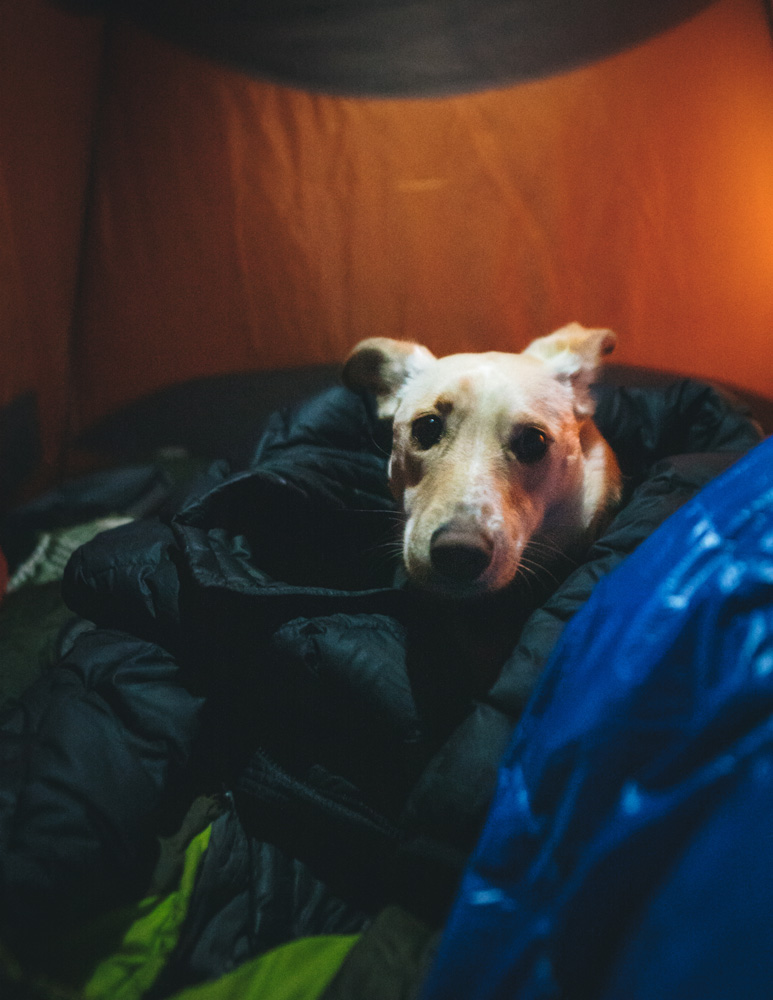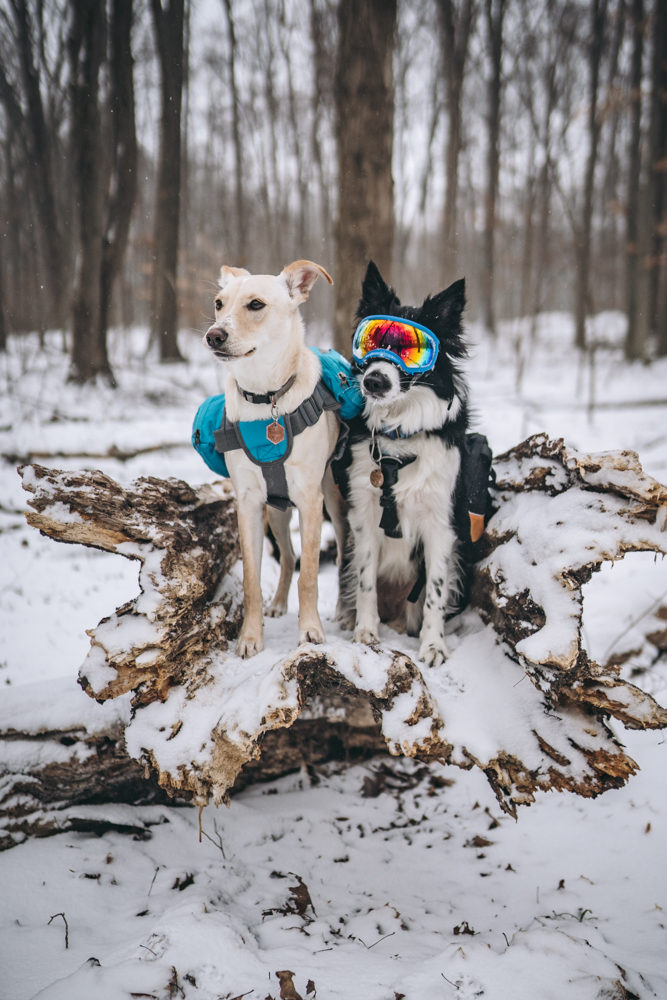

Sharing the outdoors with your canine companion can be fulfilling and rewarding, even in winter.
Dogs bring a whole new level of appreciation to our surroundings. They breathe in every smell with excitement and seem to enjoy our natural surroundings with relentless enthusiasm.
Many of us bring dogs into our lives with the intention of sharing our outdoor adventures together. For those of us that live in regions where we have cold and snowy winters for a significant part of the year, winter camping is a fun and challenging way to enjoy the outdoors.
Here are some of my tips for enjoying overnight winter camping with your dog.
1. Know your own limits first
Before considering your dog’s ability to survive and thrive in winter conditions, you must be familiar with winter camping yourself. Your dog is not going to help with the activities you need to accomplish in order to make the trip safe and enjoyable, like setting up camp, collecting wood and building a fire, cooking food, obtaining clean water, etc. Until you are confident that you possess the skills to enjoy a winter camping trip yourself, bringing your dog should not be a consideration.
2. Know your dog
Dog breeds and breed mixes yield a diverse set of traits – some may be helpful for winter camping, and some will require more gear and attention. Not only that, but a dog’s experience and tolerance in cold weather can determine their behavior and their level of comfort during your trip. Before going on an overnight trip, take hikes in the snow for a few miles at a time. Check to see if your dog is bothered by snow on their paws, or if they are shivering. If your dog acts as if he or she is in their element, then let them stay outside longer (with you, of course, don’t keep them outside alone) to monitor their behavior further.
On a winter camping trip, we tend to be more active during the day, which helps keep us warm. At night, however, temperatures drop and we leave the fire to go to our tents. This is where we experience the true test of comfort. It’s important to consider that your dog’s experience during winter day hikes can relatively easy during the day compared to the later hours of the evening and overnight.


3. Pack warm gear for your dog: jackets and booties
This is where I have fun planning my trips! Proper gear is essential to an enjoyable winter camping trip. A dog coat or jacket, booties, and a sleeping bag (either their own, or space in yours), and plenty of food and water are some of the most common gear considerations. For this article, I’ll focus on three of the most essential: a coat for warmth, paw protection, and sleeping gear.
We use a jacket that has a removable layer to help our dog maintain a comfortable temperature. There are a lot of good options available, so do your research and see what is a good fit for you and your dog. Here’s a link to the coat we use by Outward Hound. Here are some other options.
When it comes to paw protection, dogs’ limbs behave differently than ours with exposure to the cold. Many dogs are completely comfortable with their paws having direct exposure to snow for hours at a time. However, some long haired breeds get snow clumps in between their pads, and so booties serve as a deterrent to that as well. There are several brands of booties to choose from. Ruffwear and Kurgo are popular brands. Mushers and competitive sled dog teams often use a simpler design like Mountain Ridge booties. My dog is has short hair and doesn’t have a problem with clumps of snow between his pads, so we don’t often use them. Know your dog and their limits, and have the right gear for their needs.
4. Staying warm at night
Dogs can be a great source of warmth in the tent at night. My sleeping bag is a mummy-style bag and there isn’t enough room for both of us in it, so I repurposed one of my old sleeping bags to make on just for my dog. See more about my DIY dog sleeping bag here. Your dog needs warm layers inside your tent to enjoy a good night’s sleep. If you aren’t sharing a sleeping bag, make sure you have a bag for them. Even better, use it at home so they are familiar with it before camping.
5. Keep your dog active
Staying active is an important part of keeping your core temperature warm, and your dog is no different. Bring one of their favorite toys, and be sure to dedicate part of your trip for play time. When you’re on the trail, if the park rules allow it and your dog is well trained, let your dog off leash so they can walk at their own pace (likely faster than yours) and continue maintaining a safe body temperature. Please consider others when doing this, and remember that other people don’t like your dog as much as you do. When collecting wood for a fire and doing other camp tasks, let your dog come with you. They probably want to be by your side anyway. Tying out your dog when temperatures are low can limit their activity and might lead to unsafe conditions.


6. Consider bringing a friend
If your dog is a pack-dog like mine, then a dog friend will help accomplish some of the points above at the same time. Not only does another dog help keep your dog active, but they can help keep each other warm at night. Additionally, a familiar dog friend can bring a level of comfort to an otherwise new and potentially stressful experience. We know our dog, and know that a dog friend greatly increases his happiness level, so this point is an important one to us.
7. Other essential gear
There are some items I always bring with me on camping trips, especially in the winter. One is a pair of our trusty Rex Specs. If you’re not familiar with them already, Rex Specs are goggles designed specifically for dogs. They offer eye protection from foreign objects, wind, UV rays, and more. My dog likes wearing them when sticking his head out the window and also when we’re in windy conditions outside. Another essential item is a clip-on dog light. There are several expensive versions out there, but I picked up a cheap 6-pack on Amazon and they haven’t failed me yet. They are especially helpful in the winter when there are fewer hours of daylight. Clip one on and you’ll be able to spot your dog wherever they go. Other essential gear might include treats to keep them occupied at camp (bully sticks, pig ears, etc.) and also a backpack to carry it all in. We use a backpack from Outward Hound, but there are other great options available too.
8. Bring more than you think you’ll need
Because your dog is burning more calories than normal, bring a little extra food. In the case that you need to stay an extra day, you don’t want to be caught without a meal for your canine companion. Beyond food, consider bringing an extra sweatshirt or blanket, or possibly an extra puffy jacket to help add layers for your dog. Keep an eye on the weather forecast, and make sure you have plenty of layers to keep both of you warm.

I hope these tips help you and your canine companion on your winter camping excursions! Is there something I missed? Let me know! Find me on Instagram @drewmason. I’m always happy to talk about the content on my site, and dive into more detail.
